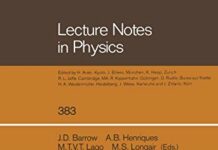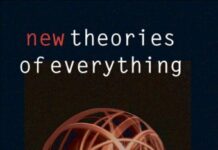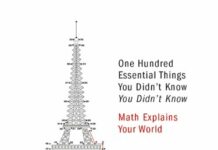
Ebook Info
- Published: 2004
- Number of pages: 742 pages
- Format: PDF
- File Size: 8.61 MB
- Authors: John D. Barrow
Description
This volume provides a fascinating snapshot of the future of physics, covering fundamental physics, at the frontiers of research. It comprises a wide variety of contributions from leading thinkers in the field, inspired by the pioneering work of John A. Wheeler. Quantum theory represents a unifying theme within the book, along with topics such as the nature of physical reality, the arrow of time, models of the universe, superstrings, gravitational radiation, quantum gravity and cosmic inflation. Attempts to formulate a final unification of physics are discussed, along with the existence of hidden dimensions of space, space-time singularities, hidden cosmic matter, and the strange world of quantum technology.
User’s Reviews
Reviews from Amazon users which were colected at the time this book was published on the website:
⭐Having acquired this publication back in 2004 (the conference itself was held March 2002), it behooves me to add that I have rarely revisited these papers. I long for the day when physicists stop trying to predict the future of their discipline ! 2021, we can see if any of these ‘predictions’ amounted to anything:(1) To my knowledge, loop quantum gravity (and the allied spin foam model) has delivered as much as string theory has delivered in terms of experimentally verifiable data, that is, nothing. Fotini Markopoulou writes: “… experiments are necessary.” (page 561). Smolin writes: “…the better we understand the laws of physics, the less the space that will be required to write them.” (page 492). Is that really so ?(2) As pointed out by others, the essay by Max Tegmark is of dubious value, to say the least. He concludes:”…the simplest and arguably most elegant theory involves parallel universes by default.” (page 490).That is a pet peeve of mine, physicists should cease using terms such as “simplest” and “most elegant.”(3) Lisa Randall writes a brief, yet lucid account, of “additional spatial dimensions.” John D. Barrow writes that “…if the constants of nature are slowly changing then we could be on a one-way slide to extinction.” (page 419). In my view, the best essay in this volume is Raymond Chiao’s “Conceptual Tension Between Quantum Mechanics and General Relativity, Are There Experimental Consequences ?” He concludes: “I suspect that there might exist superconductors which are transducers between electromagnetic and gravitational waves…” (page 276).(4) Of the “young researchers competition” winners (see Appendix B), only two of them have I followed with any zeal: Raphael Bousso and Steven Gubser. Among those fifteen names listed, one of those has departed the field of physics and Steven Gubser lost his life tragically in 2019.(5) Instead of this volume, I recommend instead two other volumes: Fundamental Problems in Quantum Theory (1995 Conference in honor of Wheeler) and Complexity, Entropy and the Physics of Information (1990, edited by Zurek).
⭐John Archibald Wheeler was born in Jacksonville, Florida in July of 1911. His parents were both librarians. Wheeler initially planned to major in electrical engineering but switched to theoretical physics. His first paper, on the band structure of the monoxides of Scandium, Yttrium, and Lanthinum, appeared when he was only 19. Wheeler obtained his Ph.D. from Johns Hopkins in 1933 (his thesis topic was the theory of the dispersion and absorption of helium). After a year at NYU, he spent a postdoctoral year (1934-5) with Niels Bohr in Copenhagen. In 1937, while at the University of North Carolina, he introduced the concept of the scattering matrix (called the “S-matrix”), a very useful tool for analyzing elementary particle events. In 1938 he became an assistant professor at Princeton, and soon advanced to a full professorship there. His graduate students included Richard Feynman and Kip Thorne. In 1976, Wheeler went to the University of Texas, where he spent ten years before returning to Princeton as a professor emeritus. In 2005, he still maintained his office in Princeton, on the wall of which hung a sweatshirt with the logo “Which part of quantum theory don’t you understand?”One of Wheeler’s ideas was geometrodynamics, in which the entire universe consisted of curved space-time. This led to some colorful comments by Wheeler, such as “Mass without Mass” and “Charge without Charge” (as well some replies such as “Equations without Solutions” and “Theories without Content”). Was there really no matter in the universe? Or didn’t it really matter? In any case, the failure of geometrodynamics to explain the existence of fermions or of gravitational singularities eventually got Wheeler to abandon this idea.Richard Feynman said that Wheeler once told him a possible explanation of why all electrons had the same mass and charge. It was because they were all the same electron! That very busy electron would travel backwards and forwards in time and show up all over the place! Feynman, not surprisingly, asked where the time-reversed electrons (namely, the positrons) would be, leaving Wheeler to wonder if they could be hidden in the nuclei somehow. Still, the idea of the time-reversed electrons became the core of the Feynman diagrams which are used in quantum electrodynamics.Many people have been inspired by Wheeler’s advice, including comments such as “Never make a calculation until you know the answer.” That is, you have to make an estimate or at least a guess before you really get started on a derivation. In addition, he’s often asked fundamental questions, including “How come existence?” and “How come the quantum?”A book called “Magic without Magic” honored Wheeler’s sixtieth birthday. This book honors Wheeler’s ninetieth birthday. It includes papers on quantum reality, cosmology, and other favorite topics of his. Many of the papers are, um, highly speculative, but they are on exciting topics and I feel they are all worthwhile and, of course, appropriate.As far as quantum reality is concerned, Wheeler and I may have, um, slightly different perspectives. Wheeler, after all, studied with Bohr. I am convinced that quantum mechanics is (and should be considered to be) a local theory, in which measurement plays no fundamental role. That’s not quite what we see in some of the papers in this volume.Lucien Hardy has a fine paper on why nature is described by quantum theory, in which he discusses the issue of continuity versus discreteness. It reminded me of Paul Dirac’s book on quantum mechanics, in which Dirac said that the need for quantum mechanics could be seen from general philosophical principles: without it there would never be a point where we could deal with an ultimate structure of matter as size would always be relative. In his paper, Freeman Dyson tells us that “everything in the future is a wave, everything in the past is a particle.” David Deutsch says that while it does no good to hypothesize that the world is “made of information,” it can be made of qubits, which are “unequivocally multiversal objects.” And there are many other fine papers on quantum reality, including those by Dieter Zeh, Wojciech Zurek, Juan Paz, Juan Maldacena, Bryce DeWitt (on the Everett many-worlds interpretation of quantum mechanics).The cosmology papers are simply wild. John Barrow wonders about yet another big question: are our constants constant? It reminds me of when Paul Dirac looked at whether the gravitational constant might be getting smaller with time, only to have Edward Teller point out that it couldn’t be getting smaller too fast, or the Sun would have been too luminous for the dinosaurs to have existed. Maybe the most speculative of these papers is Max Tegmark’s, on parallel universes, and I do think this paper could, um, use much more work.I truly enjoyed this fine book and all the papers in it.
⭐I was tempted to give only two stars because the book is rather pricey for a collection of articles most of which are freely downloadable from the internet, sometimes in greater depth or detail. However, on their own merits, these are a mixed bag of articles of varying quality that have been roped together to celebrate J.A.Wheelers seminal influence.Some of the chapters are quite good as far as they go, and roughly speaking the first half of the book on quantum reality is by far the best, after which the standard drops off somewhat. There is quite a bit of whacky nonsense in the latter half, amongst the worst of which is Max Tegmark’s loony multiverse chapter which packs in more misinformation, non-sequiturs, faulty logic and sloppy reasoning per paragraph than any piece I have ever come across before purporting to be physics.Overall, fairly interesting and stimulating but so is browsing the internet where most of this and much more can be found.
⭐well written, although sometimes complex, chapters basically covering the state-of-the-art in cosmology by numerous physics luminaries. I totally disagree with other reviewers assertions that this is a “stealth” creationist tome…since the vast majority of the authors have only presented what is empirical assertions/hypothesis backed up by the latest mathmatics and data, to this point; and many of the authors have no creationist leanings what-so-ever….and BTW, who cares who funds it?…I enjoyed this book.
⭐
Keywords
Free Download Science and Ultimate Reality: Quantum Theory, Cosmology, and Complexity in PDF format
Science and Ultimate Reality: Quantum Theory, Cosmology, and Complexity PDF Free Download
Download Science and Ultimate Reality: Quantum Theory, Cosmology, and Complexity 2004 PDF Free
Science and Ultimate Reality: Quantum Theory, Cosmology, and Complexity 2004 PDF Free Download
Download Science and Ultimate Reality: Quantum Theory, Cosmology, and Complexity PDF
Free Download Ebook Science and Ultimate Reality: Quantum Theory, Cosmology, and Complexity



